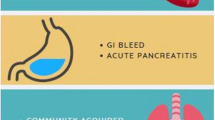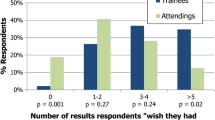Abstract
Objectives
Delivery of low-value healthcare impacts patients, resources, and overall healthcare sustainability. In Canada, an estimated 30% of tests, treatments, and procedures are unnecessary. As primary decision-makers, physicians have a major influence on healthcare utilisation. Despite numerous approaches to reduce low-value testing, success has been limited. Audit and feedback strategies have demonstrated variable effects in changing physician practice and often do not consider resource requirements. The objective of this study is to evaluate a resource-effective approach to decrease low-value testing in the emergency department (ED) through online education and personalised audit and feedback scorecards for two common ED tests.
Methods
A single-centre, prospective pre–post trial of 31 ED physician’s ordering rates of urine cultures and rib X-rays was conducted at an academic community hospital in Ottawa, Ontario. The study included educational interventions on appropriate ordering guidelines and personalised audit and feedback scorecards from 2019 to 2020.
Results
There was a 36.9 and 81.6% relative reduction in urine culture and rib X-ray ordering, respectively, between the baseline intervention and the 12-month post-scorecard period (p < 0.01). The group dispersion in ordering rates during the post-scorecard period was smaller compared to the wide dispersion at baseline. The rate of return ED visits for both tests remained unchanged. Variable cost analysis demonstrated $53,300 in cost-savings from reduced testing rates during the study period. The total study cost was $15,000.
Interpretation
The combination of online education and personalised audit and feedback scorecards may present a resource-effective approach to change physician practice and reduce low-value testing in the ED. Further studies are needed to examine this approach in other departments and clinical topics in Canada.
Résumé
Objectifs
La prestation de soins de santé de faible valeur a un impact sur les patients, les ressources et la durabilité globale des soins de santé. Au Canada, on estime que 30 % des tests, des traitements et des procédures sont inutiles. En tant que principaux décideurs, les médecins ont une influence majeure sur l'utilisation des soins de santé. Malgré de nombreuses approches visant à réduire les tests de faible valeur, le succès a été limité. Les stratégies de vérification et de rétroaction ont démontré des effets variables sur l’évolution de la pratique des médecins et ne tiennent souvent pas compte des besoins en ressources. L'objectif de cette étude est d'évaluer une approche efficace en termes de ressources pour réduire les tests de faible valeur dans le service des urgences grâce à une formation en ligne et à des fiches d'audit personnalisés et de rétroaction pour deux tests courants aux urgences.
Méthodes
Un essai prospectif avant-après dans un seul centre portant sur les taux de prescription de cultures d'urine et de radiographies des côtes par trente et un médecins du service d'urgence a été mené dans un hôpital communautaire universitaire à Ottawa, en Ontario. L'étude comprenait des interventions éducatives sur les directives de commande appropriées et des fiches d'audit et de retour d'information personnalisées de 2019 à 2020.
Résultats
Il y avait une réduction relative de 36,9 % et 81,6 % de la culture d'urine et de la commande de radiographies des côtes respectivement, entre l'intervention de base et la période de 12 mois après la fiche de notation (p < 0,01). La dispersion des groupes dans les taux de commande au cours de la période post-bilan était plus faible par rapport à la large dispersion au départ. Le taux de retour des visites aux urgences pour les deux tests est resté inchangé. L'analyse des coûts variables a montré que la réduction des taux de dépistage pendant la période d'étude a permis de réaliser des économies de 53 300 dollars. Le coût total de l'étude s'est élevé à 15 000 dollars.
Interprétation
L'association d'une formation en ligne et de fiches d'audit et de retour d'information personnalisées peut constituer une approche efficace en termes de ressources pour modifier les pratiques des médecins et réduire les tests à faible valeur dans les urgences. D'autres études sont nécessaires pour examiner cette approche dans d'autres départements et sujets cliniques au Canada.
Similar content being viewed by others
References
Barua B, Palaxios M, Emes J. The sustainability of health care spending in Canada. Fraser Institute; 2016.
Canadian Institute for Health Information. Unnecessary Care in Canada. Ottawa, ON: CIHI; 2017.
Canadian Foundation for Health Improvement. The impact on emergency department utilization of the CFHI Healthcare Collaborations and Initiatives. 2013.
Gupta DM, Boland RJ Jr, Aron DC. The physician’s experience of changing clinical practice: a struggle to unlearn. Implementation Sci. 2017;12(1):28.
Atkinson P, Lang E, Mackenzie M, Hiranandani R, Lys R, Laupacis M, et al. CJEM debate series: #choosingwisely - the choosing wisely campaign will not impact physician behaviour and choices - CORRIGENDUM. CJEM. 2019;21(5):E10.
Jamtvedt G, Flottorp S, Ivers N. Improving healthcare quality in Europe: Characteristics, effectiveness and implementation of different strategies. In: Busse R, Klazinga N, Panteli D, Quentin W, editors. European Observatory Health Policy Series. Copenhagen (Denmark): European Observatory on Health Systems and Policies. © World Health Organization (acting as the host organization for, and secretariat of, the European Observatory on Health Systems and Policies) and OECD; 2019.
Shuaib W, Vijayasarathi A, Tiwana MH, Johnson JO, Maddu KK, Khosa F. The diagnostic utility of rib series in assessing rib fractures. Emerg Radiol. 2014;21(2):159–64.
McRitchie D, Sidhu K, Ennis A, Asalya M. Give the test a rest: a toolkit for decreasing unnecessary emergency department laboratory testing choosing Wisely Canada; 2019.
Stagg A, Lutz H, Kirpalaney S, Matelski JJ, Kaufman A, Leis J, et al. Impact of two-step urine culture ordering in the emergency department: a time series analysis. BMJ Qual Saf. 2018;27(2):140–7.
Dowling SK, Gjata I, Solbak NM, Weaver CGW, Smart K, Buna R, et al. Group-facilitated audit and feedback to improve bronchiolitis care in the emergency department. CJEM. 2020;22(5):678–86.
Brehaut JC, Colquhoun HL, Eva KW, Carroll K, Sales A, Michie S, et al. Practice feedback interventions: 15 suggestions for optimizing effectiveness. Ann Intern Med. 2016;164(6):435–41.
Funding
This study was funded by Montfort Hospital Department of Emergency Medicine.
Author information
Authors and Affiliations
Corresponding author
Ethics declarations
Conflict of interest
There are no conflicts of interest to report.
Supplementary Information
Below is the link to the electronic supplementary material.

Rights and permissions
About this article
Cite this article
Gandhi, R., Lessard, R. & Landry, S. Reducing low-value testing in the emergency department through cost-effective physician education and personalised audit and feedback scorecards. Can J Emerg Med 24, 214–218 (2022). https://doi.org/10.1007/s43678-021-00220-w
Received:
Accepted:
Published:
Issue Date:
DOI: https://doi.org/10.1007/s43678-021-00220-w




